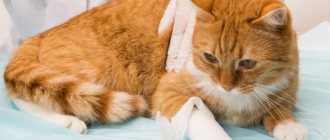The cat is a very active pet. He loves to climb trees, jump, get into hard-to-reach places, and even sometimes fight. But such pranks do not always end well; the cat quite often inflicts various injuries on itself.
One of the most common problems affecting our furry friends is ear disease. How to determine the location of an injury or understand the cause of your cat's anxiety? First you need to observe the symptoms.
Symptoms
If your cat has swollen ears, the following symptoms may appear:
- elevated temperature;
- odor from the ear;
- redness or swelling of the skin;
- the cat walks with its head tilted, shakes or twitches it, scratches its ears with its paws.
There may be several reasons why a cat's ear is swollen. Let's look at the main ones.
Ticks (otodectosis)
This is one of the common cat diseases. In 80% of cases this is what is diagnosed. The disease is caused by a mite called Otodectes cynotis, which parasitizes your pet's skin in the upper layers of the epidermis.
Ticks can appear when a healthy animal comes into contact with a sick animal, and can also enter the body through fleas or flies. Many may ask: “Why does my furry dog have mites, since we always stay at home?” The answer is simple: the person himself could carry the infection, for example, on shoes or clothes, although this parasite is not dangerous for us!
Mostly kittens up to one year old or adults with weakened immune systems get sick. Moreover, the disease mainly begins in the summer, because ticks love warmth.
Treatment
If a cat's ear is swollen due to ticks, what should I do?
To defeat the disease, you must follow the following stages of treatment:
- Treat the ear canal with an antiseptic. Remove all crusts and scabs from the damaged area and treat for pus. Hydrogen peroxide can be used as an antiseptic. Use cotton swabs when cleaning the ear canal.
- Use of anti-tick drugs. After treating the animal's ears, you need to massage them thoroughly.
- If the disease is advanced, you may need acaricidal injections.
- If your pet is very concerned about itching and irritation, then you can use the antibacterial agent Otonazole.
- To effectively treat ear mites, you need to take care of strengthening your pet’s immunity. This can be done by adding beneficial minerals and vitamins to your diet.
Otitis (middle ear disease)
If your cat's ear is swollen, otitis may be the cause. It is most often caused by parasitic diseases, allergic manifestations (pollen, dry food, dust), bacterial, viral, fungal infections, and injuries. In addition, it may be poor hygiene of the ear canal.
Factors that provoke otitis media are hypothermia, reduced immunity, moisture getting into the ears, genetics (predisposition in the British and Scottish fold breeds).
Main symptoms
If a cat's ear is swollen inside or outside, symptoms include:
- animal anxiety;
- redness and irritation of the skin of the ear;
- pain effect;
- purulent discharge;
- decrease in animal activity;
- lack of appetite.
Experts classify inflammation into three types: external, internal and middle ear. If a cat's ear is swollen from the outside (with otitis externa), the affected tissue is on the surface and does not affect the eardrum. Such otitis media can be easily dealt with.
Otitis media is the most common and most often becomes chronic. With this type of disease, inflammation spreads to the eardrum. The most dangerous is inflammation of the inner ear. Not only the eardrum is affected, but also the vestibular apparatus. Inflammation is accompanied by purulent discharge, which can spread to the brain; in addition, this type of disease can lead to deafness of the animal.
Symptoms of otitis media include:
- the animal tilts its head;
- lopsided muzzle;
- problem with swallowing (due to disruption of the facial nerve);
- trembling of the eyeball (the disease has spread to the brain).
How to understand that a cat is bothered by a sore ear, symptoms
The following symptoms indicate inflammatory lesions:
- loss of appetite;
- the auricle turns red, swells, and the local temperature rises;
- the pet shakes its head, as if trying to shake out a foreign object from the organ of hearing;
- you can hear the fluid gurgling in the affected organ;
- the cat scratches its ear with its paw;
- the animal meows pitifully;
- tilts his head towards the disturbing organ of hearing;
- upon examination, crusts are found, as well as pus or discharge resembling coffee grounds;
- drooping lip, eyelid or ear;
- the pet avoids stroking the head;
- the ear smells unpleasant.
Be sure to read:
Gingivitis in cats: how to recognize and treat the disease
Otitis is characterized by exhausting pain, however, if the disease is detected at the initial stage, then the cat can be helped.
Treatment of the disease
If a cat's ears are swollen, what should I do? If your pet exhibits the symptoms listed above, you must immediately contact a veterinary service, where you will be prescribed qualified treatment.
Treatment begins with cleaning the ear canal from scabs, dirt, and pus using antiseptic drugs. If the inflammation is purulent, deep surgical cleaning is an option. After cleaning, the ear is treated with special medications. But remember: you cannot choose the drug yourself! You may harm the animal. Your task as the owner throughout the treatment is to provide your pet with a warm room, free from drafts and dampness.
To prevent otitis media, it is recommended not to allow the animal to become hypothermic, not to wet the ears when bathing, and to maintain hygiene of the ear canals.
How to treat a swollen ear in a kitten
A swollen ear should be treated based on why it is swollen. Therefore, first of all, you need to identify the cause of the swelling, and then begin to eliminate the disease. Only a veterinarian can 100% accurately determine the cause and draw up a treatment plan. This means that at the first symptoms of an ear tumor, the kitten needs to be taken to the hospital, where he will receive qualified assistance. Remember, home treatment can be not only useless, but even dangerous if the diagnosis is incorrect.
Read more about treatment at home: Is it possible to treat cats at home?
Directly at the clinic, the animal will take all the necessary tests and undergo an examination. Based on the results of the study, a treatment plan will be prescribed for your pet. These will be special anti-inflammatory antibiotics and local antitumor agents. For example, antibacterial ointments Ichthyol, Sintomycin, Levomekol. In particularly severe cases, surgery may be required.
There are many reasons why a kitten's ear may become swollen. Therefore, you should not self-medicate. At the first signs, you should immediately contact a veterinarian for qualified help.
Hematomas
There may be another reason why a cat's ear is swollen - hematoma. It resembles a swelling, which is provoked by hemorrhage in the area between the cartilage and the skin of the ear.
The formation of a hematoma can be caused by mechanical damage, since the ear skin has a very thin structure, which is equipped with many capillaries. When a vessel is damaged, blood accumulates between the tissues, after which it acquires a bluish tint. Such injuries are most often sustained by cats that have free access to the outdoors. Your active pet can get injured anywhere from a fall from a tree to a fight with a yard dog. Sometimes the cat itself causes damage to blood vessels when scratching its ear.
Treatment of hematoma
If a cat has a swollen ear, how to treat it? At the initial stage of a hematoma, it is possible to apply cold. Frozen foods from the freezer are perfect for cooling. You can cool the ear for no more than 15 minutes. If the wound is open, do not forget to disinfect it. In case of a bleeding wound, it is necessary to apply a bandage. And a veterinary service specialist will take care of further treatment and diagnostics.
If the cat has a large hematoma and you are afraid of introducing an infection into the wound, then in this case the surgical method is used. The doctor makes an incision in the area of the hematoma, after which the wound is cleaned of darkened blood, and at the end of the operation a suture and bandage are applied. After such an operation, you must ensure that the cat cannot scratch its ear. To do this, you can use a special collar.
To prevent hemorrhage, adhere to the following rules:
- try to stay close to the animal while walking;
- promptly identify and treat ear diseases;
- rid the animal of parasites in a timely manner.
Why do cats get swollen ears?
The Murkoshi team has counted several possible reasons why a cat’s ear may become swollen, and is in a hurry to share this information with you.
The first reason is a possible tick bite, or more precisely, inflammation associated with a blood-sucking parasite. After getting rid of the parasite, the swelling will subside on its own within a few days.
Read more about tick bites: How to protect your cat from ticks
The second reason is otitis media, which can also cause swelling in the ear area. But it is very difficult to recognize in the early stages, because it is almost impossible to see minimal inflammation inside the ear.
Read more about this disease: Treatment of otitis media in cats
The third factor is “bruises”, which form a swollen area due to the large volume of blood. By the way, the site of the hematoma will definitely be hot. If there is a hematoma, the cat may shake and scratch its ears. If the “bruises” are not treated, the pet may experience complications in the form of death of the cartilage tissue of the ear.
The fourth possible cause of ear swelling is an abscess that forms after an injury with subsequent suppuration.
The fifth reason is lymphatic extravasation, which also occurs due to injury. But in this case, instead of pus, a bubble filled with lymph and blood is formed. Hence the name of the disease.
The sixth reason is neoplasms in the form of papilloma, fibroma or sarcoma. If there is severe growth in the ear, there is a possibility that the eardrum will close. Which can have a detrimental effect on your pet’s hearing and cause deafness.
Abscess
When tissue is damaged, a purulent-inflammatory process called an abscess may begin.
An abscess in an animal can occur as a result of injury, damage to the skin with infection.
One of the factors that provokes a purulent abscess is the animal’s reduced immunity, age and concomitant diseases. The consequences of an abscess can be serious; the purulent mass can penetrate deep-lying tissues and cause serious harm to the body.
Symptoms of an abscess include:
- decreased appetite, lethargy of the animal;
- the cat constantly drinks water;
- the abscess area has swelling, redness, and heat.
Types of bumps under the skin of a cat
Cones can have a different nature, depending on the animal’s predisposition to a particular disease.
Lipoma (wen)
At first, a small formation appears, which gradually grows and can grow to the size of a chicken egg. The cause of lipoma is improper distribution of fat after clogged pores. Lipoma is a benign neoplasm that does not metastasize and does not cause discomfort. The exception is if the lipoma occurs on the back or neck. The lipoma does not hurt even when pressed, it does not affect life processes: the appetite is preserved, the animal’s normal behavior, the temperature is normal.
In older animals, the appearance of lipomas may indicate the onset of cancer. You should definitely have your cat examined by a veterinarian.
Abscess
An abscess appears at the site of a bruise, any internal injuries, or in case of an incorrect injection.
The tumor appears approximately on the 3rd day after injury, gradually growing.
Unlike a lipoma, an abscess is a painful condition, accompanied by an increase in temperature and depression of the pet’s condition.
The abscess is firm to the touch, but not hard. You can feel accumulated pus inside. If the abscess is not completely healed, pus is released into the hole when pressed.
Lymphadenitis
Inflammation of the lymph nodes. The lump is extremely painful even with slight pressure. The animal's condition is depressed, the temperature is elevated, and the appetite is reduced.
Cyst
A cyst is a benign tumor. A cyst is a lump filled with fluid from the inside. This tumor grows slowly and does not affect the cat’s condition; the cyst is not painful.
Tumor as a reaction to vaccination
Usually there is a slight swelling, a little painful, accompanied by redness.
Oncology
The most terrible type of neoplasm. This is what the owner thinks about when he feels a lump on his pet’s body. Cancer spreads very quickly and metastasizes throughout the body. Inevitably leads to the death of the animal, but in the first stages of the disease it often does not manifest itself.
Abscess treatment
In order not to harm your pet, the best help is to go to the doctor, but if you need to do this urgently, and the cat has a normal temperature and the injury is small, then try to help your cat yourself. What do we have to do:
- Shave the area around the abscess.
- Wash and disinfect your hands.
- Squeeze out the pus using sterile wipes.
- Clean the affected area of pus using a sterile cotton swab.
- Treat the wound with hydrogen peroxide.
- Cover the wound with streptocide.
Diagnostics
If you find a lump behind your cat's ear, do not hesitate. It is advisable to take her to the vet immediately. To determine the nature of the swelling, the doctor conducts a visual examination and interviews the animal’s owner. The main questions that interest the doctor:
- Does the animal have a free range?
- Has the cat been in a fight lately?
- Are there any changes in the pet's behavior?
Then, by palpation, the nature and structure of the neoplasm is determined: soft or hard, painful or not, whether it has purulent contents.
Laboratory and instrumental methods. Sometimes an initial examination is enough to determine the cause of the lump. But if the veterinarian cannot make a diagnosis based on visible signs, he prescribes additional tests:
- radiography;
- computed tomography;
- blood and urine tests;
- histology or cytology;
- Ultrasound;
- puncture and biopsy.
Based on the results obtained, the doctor determines the cause of the lump and prescribes treatment.











